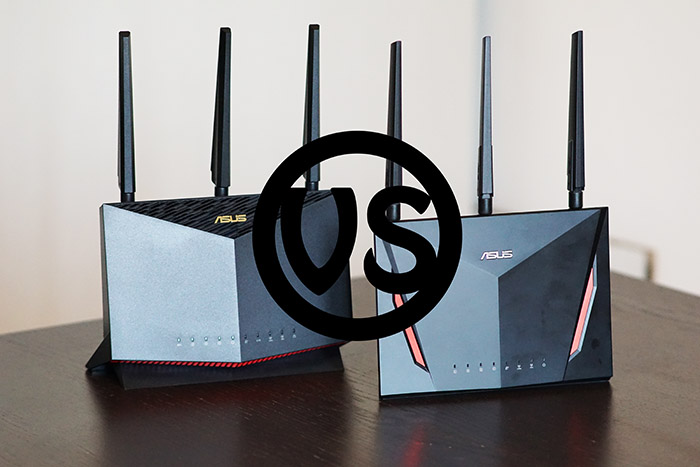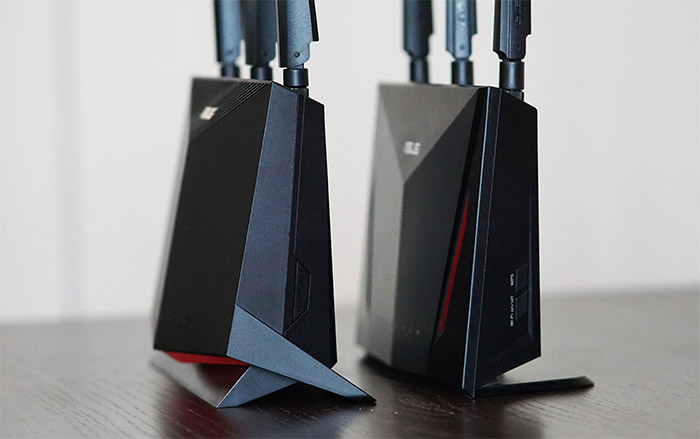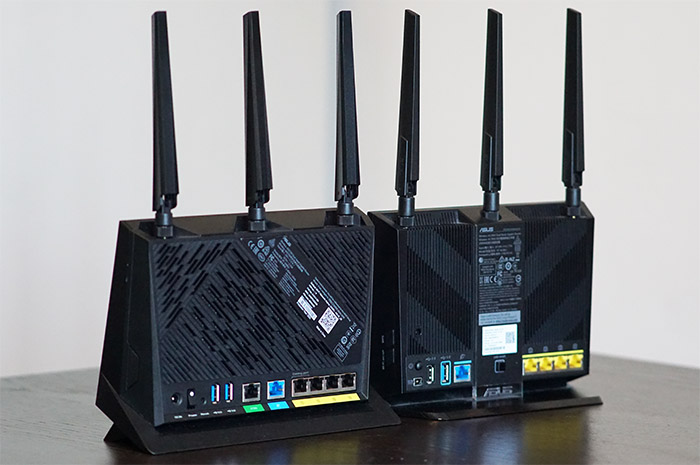The Asus RT-AX86U is the WiFi 6 replacement to the Asus RT-AC86U and, while I’m sure most of you are curious whether it’s finally time to move to a better router, this is also a good opportunity to check out some of the main differences between the WiFi 5 and WiFi 6 features (in general), as well as focus towards the advancements that Asus did in the consumer-based networking department. The Asus RT-AC86U is about 3 years old and, while it wasn’t the flagship model, it was the first router to support AiMesh out of the box and it was equipped with a powerful CPU which has helped a great deal with the VPN performance.
The wireless performance was also excellent which is why the RT-AC86U remained a popular choice over the years, but, now we have the Asus RT-AX86U and, while it’s definitely a phenomenal router and a complete upgrade over its predecessor, it may still be hard to justify an upgrade. It’s clearly worth it if you need a multi-Gigabit port (WAN or LAN), a far better wireless performance and coverage (especially if you have a lot of resource-heavy clients) and if you already have at least some WiFi 6 clients in your home. That being said, let’s put these two router next to each other and see whether the WiFi 6 features are worth it and if it’s time to move from the Asus RT-AC86U to the RT-AX86U.
Note: You can also check out the individual analysis of each mesh WiFi system here: Asus RT-AX86U and Asus RT-AC86U.
Design and Build Quality
The Asus RT-AC86U has kept the design concept of the RT-AC68U, so the router can only stand vertically, lacking the possibility to be mounted on the wall and it seems that this has become sort of a characteristic element for this series since the RT-AX86U went with the same approach. Except for the front panel, there wasn’t that much difference between the RT-AC68U and the RT-AC86U, but the Asus RT-AX86U is completely redesigned, featuring a wider case (although a bit shorter) and the permanently attached stand is made out of two pieces (which makes for a difficult tear-down process), instead of a single larger slab as seen on the RT-AC86U. It’s worth noting that the Asus RT-AX86U measures 9.44 x 6.41 x 3.14 inches (without the antennas) and the Asus RT-AC86U measures 8.6 x 6.3 x 3.2 inches which means that both will require pretty much the same space from your desk. The antennas are also removable, therefore upgradable on both devices and that V-shaped front panel is something that Asus has kept on the WiFi 6 wireless router as well, but the red accents are gone.
Well, more like out of view because, while the RT-AC86U proudly wears its red stripes on the front panel, the Asus RT-AX86U is a bit shy regarding its gaming abilities (unlike the RT-AX82U which is one of the flashiest ‘gaming’ routers that Asus ever designed), so it has positioned a red plastic section pointing downwards (also doubles down as a ventilation area). The Asus RT-AC86U had the same ventilation cut-outs as RT-AC68U but, due to a far more efficient power handling, the router operated at an adequate temperature (unlike its predecessor) and I noticed that the RT-AX86U is far more generous in terms of vent cut-outs. So, it’s not only the rear section that’s now covered by a weird pattern of longitudinal holes (looks very crowded), but the top part of the front panel will also allow the air to flow inside the case. This way, the Asus RT-AX86U, just like the RT-AC86U always works at a proper temperature, showing no signs that it may overheat. The LEDs are positioned in the same place on both wireless routers and I saw the same four LAN LEDs, the WAN LED, the Power and the two WiFi LEDs, but the RT-AX86U has additional two indicators, one for WPS and the other for the 2.5Gbps port.
The Asus RT-AC86U had the WPS and the WiFi On/Off buttons together on the right side, while the RT-AX86U has positioned the WPS button on the left side and the LED On/Off button on the right – everything else can be found on the rear side of the routers. The RT-AC86U has its LED On/Off button in the middle, while the four Gigabit LAN ports lie on the right side and the Gigabit WAN port, the two USB ports (2.0 and 3.0), as well as the Power button and the Power port sit on the left side (there is also a camouflaged Reset button within the cut-out pattern). The ports and connectors on the Asus RT-AX86U feel more relaxed (more space in between them), so you can find the Power button next to the Power port, a small recessed Reset button, two USB ports (both 3.0), four Gigabit LAN ports (from which the first is a Gaming port – will have the highest priority) and there is one WAN port, as well as a 2.5GbE port which can either work as LAN or WAN.
Verdict: I do like the slim profile of the RT-AC86U and while it clearly has everything that is required from an excellent WiFi 5 router, the Asus RT-AX86U is simply better – sure, both have a great airflow, there are all the expected ports, but the extra 2.5GbE port that can work as either WAN or LAN and the two USB 3.0 ports ensure that the Asus RT-AX86U wins this round.
Internal Hardware
After opening the case of the Asus RT-AX86U, I was pleasantly surprised to see that, similarly to the RT-AC86U, it has an extra antenna and the CPU is very similar to the three-year old wireless router. That being said, the Asus RT-AX86U is equipped with a quad-core Broadcom BCM4908 SoC (ARM Cortex-A53) clocked at 1.8GHz, it has 1GB of RAM (Nanya NT5CC256M16ER-EK), 256MB of flash storage (MXIC MX30LF2G189C-TI) and, as for the WiFi chips, the router relies on Broadcom BCM43684KRFBG 802.11a/n/ac/ax 4×4:4 for the 5GHz radio and on the Broadcom BCM6710KFFBG 802.11b/g/n/ax 3×3:3 for the 2.4GHz radio. The Asus RT-AC86U is equipped with a dual-core Broadcom BCM4906 SoC (ARM Cortex-A53 – same architecture) clocked at 1.8GHz, 512MB of RAM (Micron MT41K256M16TW) and 256 MB of flash memory from Macronix. As for the WiFi chips, the RT-AC86U relies on the Broadcom BCM4365E 802.11a/b/g/n 3×3:3 SoC for the 2.4GHz band and on the Broadcom BCM4366E 802.11a/b/g/n/ac 4×4:4 SoC for the 5GHz network.
| Asus RT-Ax86U | Asus RT-AC86U | |
| CPU | quad-core 1.8GHz Broadcom BCM4908 (ARM Cortex A53) | dual-core Broadcom BCM4906 (ARM Cortex-A53) |
| RAM | 1GB | 512MB |
| Storage | 256MB | 256MB |
| 5GHz Radio | Broadcom BCM43684KRFBG 802.11a/n/ac/ax 4×4:4 | Broadcom BCM4366E 802.11a/b/g/n/ac 4×4:4 |
| 2.4GHz Radio | Broadcom BCM4365E 802.11a/b/g/n 3×3:3 | Broadcom BCM6710KFFBG 802.11b/g/n/ax 3×3:3 |
| LAN Ports | 4+1 | 4 |
| USB Ports | 2x USB 3.0 | 2 (1x USB 2.0 + 1x USB 3.0) |
Note: For anyone that’s interested in the theoretical maximum data transfer rate (which shouldn’t really be used as a reference to real-life performance), know that the Asus RT-AC86U is an AC2900-class router (750Mbps on the 2.4Ghz band and 2,167Mbps on the 5GHz band) and the Asus RT-AX86U is an AX5700-class router (861Mbps on the 2.4GHz band and 4,804Mbps on the 5Ghz band).
Verdict: It’s a bit surprising that there aren’t major differences between the two routers in terms of internal hardware which shows just how well equipped the Rt-AC86U was for its time. But, the Asus RT-AX86U is still an overall improvement in this department as well, so it also wins this round.
Features and Performance
The Asus RT-AC86U relies on some of the most popular WiFi 5 features, such as BeamForming or MU-MIMO and, since the RT-AX86U is a WiFi 6 wireless router (draft-stage), most of the used technologies should significantly improve the performance over the last WiFi generation. And indeed they are, especially the OFDMA (Orthogonal Frequency Division Multiple Access) which splits the channel bandwidth into smaller sub-carriers (resource units) that can be used for moving smaller packets faster and more efficiently (at a lower latency) between the router and the compatible client device. And the RT-AX86U seems to have implemented this feature bi-directional; it’s worth mentioning that using the Asus RT-AC86U, each client will have assigned a sub-carrier one at a time, so it’s far less efficient than when using OFDMA. The 1024QAM modulation is still present on both routers (yes, the RT-AC86U has been using Nitro-QAM since the day it was released) and the WiFi router also comes with MU-MIMO (for serving multiple clients at the same time) and BeamForming (for focusing the signal towards the compatible clients, therefore minimizing the impact of interference and improving the throughput).
Besides OFDMA, one other major difference is the support for 160MHz channel bandwidth – if you have client devices that support it, then the Asus RT-AX86U can go up to 160MHz, while the RT-AC86U can only go up to 80MHz (on the 5GHz radio band, obviously). Without a doubt, the Asus RT-AX86U features and technologies are better than what you’ll see on WiFi 5 routers (yes, including the RT-AC86U) but there are two problems that need to be addressed before considering an upgrade. First, there’s the compatibility issue – there aren’t many WiFi 6 clients available and, unless you went out of your way to upgrade the WiFi cards in your laptops or PCs, you’re most likely still using only WiFi 5 devices; the funny thing is that even the Asus RT-AC86U has many technologies that aren’t yet implemented within the large majority of WiFi cards (MU-MIMO and BeamForming are fine examples). So, unless you have compatible clients, you won’t see that much of an improvement by going from the WiFi 5 to the WiFi 6. The second problem is WiFi 6E. Unfortunately, the developers have created so much chaos in the networking department (not only for the consumers, mind you), that before having a steady and natural adoption of the WiFi 6, they’ve already released the next WiFi gen which is why a lot of people suggest skipping the WiFi 6 generation entirely and I don’t blame them.
Of course, there is one technology that’s still constantly maintained by Asus and that’s the AiMesh which has been a decent competitor for the dedicated WiFi mesh systems over the years. The reason for that is because it’s easy to inter-connect Asus routers from different generations (yes, even WiFi 5 with WiFi 6 devices) in order to create a fully functional mesh network and take advantage of all its unique features. This includes the creation of optimized paths for the data between nodes and the auto-healing property where a mesh node (router) will take the place of an Asus router that has failed.
Mark is a graduate in Computer Science, having gathered valuable experience over the years working in IT as a programmer. Mark is also the main tech writer for MBReviews.com, covering not only his passion, the networking devices, but also other cool electronic gadgets that you may find useful for your every day life.
[ad_2]









0 Comments: